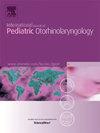Longitudinal follow-up of hearing, speech, and language skills in 6-year-old children with congenital moderate hearing loss
IF 1.2
4区 医学
Q3 OTORHINOLARYNGOLOGY
International journal of pediatric otorhinolaryngology
Pub Date : 2024-11-01
DOI:10.1016/j.ijporl.2024.112148
引用次数: 0
Abstract
Objectives
Children born with moderate hearing loss present with speech and language outcomes at both ends of the spectrum. To explore reasons for this, the objective of this study was to follow up a group of children born with moderate sensorineural hearing loss at 6 years of age (n = 7) by investigating their outcomes in hearing, speech, and language development from time point of hearing aid fitting at 6 months. Another objective was to investigate the relationship between earlier outcomes on precursing variables to the current status in auditory, speech and language development.
Method
Earlier data from a project with the same participants of auditory variables, speech, and language development were compared to the current study outcomes at 6 years of age. Children in this study performed standardized tests of phonology (SVANTE), expressive vocabulary (BNT), and speech-in-noise test (Hagerman's sentences). Parents reported on their child's functional auditory performance in everyday life (PEACH), and demographics and general development (questionnaire). Etiology and frequency of speech and language-directed intervention from time point of diagnosis to 6 years of age were collected through medical journals.
Results
Hearing levels were stable over time in all children but one, who had received bilateral cochlear implants. Performance on speech-in-noise testing varied in aided condition (−0.8 to 8, mean 2.65, SD 3.09) and unaided condition (7.2 dB–21.2 dB, mean 12.06, SD 4.82). Scores on the PEACH indicated further review in four of the seven children. Mean group score on consonant proficiency had increased from 3 to 6 years of age and were within age norms. Vocabulary scores were below the norms of children with typical hearing. Outcomes on vocabulary measures at 2.5 years showed strong correlations that were significant to scores on the BNT at 6 years of age (r = 0.87, p = 0.05). Correlations between hours of hearing aid use and vocabulary was not significant at 6 years of age. The frequency of intervention sessions in the first 6 years varied between participants (4–55, mean 19.1, SD 17.1).
Conclusion
Despite homogeneous hearing and other background variables in the participants from birth, large individual variations in speech and language outcomes at 6 years of age were found. Considering the many factors involved that impact the development of children with moderate hearing loss, the results suggest that monitoring early precursors in auditory, speech and language development may be helpful in setting commensurate goals for each child. Detecting additional conditions that may pose challenges in future speech and language as early as possible is important. There is ample room for improvement in terms of increasing the frequency of intervention for children with moderate hearing loss and their families.
对患有先天性中度听力损失的 6 岁儿童的听力、言语和语言能力进行纵向跟踪。
目标:先天性中度听力损失儿童的言语和语言表达能力两极分化。为了探究其中的原因,本研究的目的是对一组出生时患有中度感音神经性听力损失的儿童(n = 7)在 6 岁时进行随访,调查他们从 6 个月时佩戴助听器开始的听力、言语和语言发育情况。另一个目的是调查早期前兆变量结果与当前听觉、言语和语言发展状况之间的关系:方法:将一个由相同参与者参与的项目中关于听觉变量、言语和语言发展的早期数据与当前研究中 6 岁儿童的结果进行比较。参加本次研究的儿童进行了标准化的语音测试(SVANTE)、词汇表达测试(BNT)和噪音语言测试(哈格曼句子)。家长汇报了孩子在日常生活中的听觉功能表现(PEACH)、人口统计学和一般发展情况(问卷)。我们还通过医学期刊收集了从确诊到 6 岁期间的病因和语言干预频率:除一名接受过双侧人工耳蜗植入手术的儿童外,其他儿童的听力水平均保持稳定。噪声语言测试的成绩在有辅助条件(-0.8 至 8,平均 2.65,标差 3.09)和无辅助条件(7.2 分贝至 21.2 分贝,平均 12.06,标差 4.82)下有所不同。在 PEACH 测试中,7 名儿童中有 4 名的得分表明他们需要进一步复习。辅音熟练程度的小组平均得分在 3 到 6 岁期间有所提高,且符合年龄标准。词汇得分低于正常听力儿童的标准。2.5 岁时的词汇量测量结果与 6 岁时的 BNT 分数有显著的相关性(r = 0.87,p = 0.05)。助听器使用时长与 6 岁时的词汇量之间的相关性不显著。前 6 年的干预次数因人而异(4-55 次,平均 19.1 次,标准差 17.1 次):结论:尽管参与者从出生起就具有相同的听力和其他背景变量,但他们在 6 岁时的言语和语言成果却存在很大的个体差异。考虑到影响中度听力损失儿童发育的因素很多,研究结果表明,监测听觉、言语和语言发育的早期先兆可能有助于为每个儿童设定相应的目标。尽早发现可能对未来言语和语言发展构成挑战的其他情况非常重要。在增加对中度听力损失儿童及其家庭的干预频率方面,还有很大的改进空间。
本文章由计算机程序翻译,如有差异,请以英文原文为准。
求助全文
约1分钟内获得全文
求助全文
来源期刊
CiteScore
3.20
自引率
6.70%
发文量
276
审稿时长
62 days
期刊介绍:
The purpose of the International Journal of Pediatric Otorhinolaryngology is to concentrate and disseminate information concerning prevention, cure and care of otorhinolaryngological disorders in infants and children due to developmental, degenerative, infectious, neoplastic, traumatic, social, psychiatric and economic causes. The Journal provides a medium for clinical and basic contributions in all of the areas of pediatric otorhinolaryngology. This includes medical and surgical otology, bronchoesophagology, laryngology, rhinology, diseases of the head and neck, and disorders of communication, including voice, speech and language disorders.

 求助内容:
求助内容: 应助结果提醒方式:
应助结果提醒方式:


